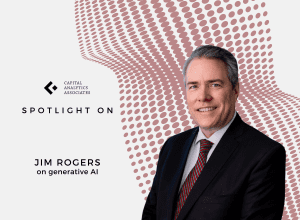Spotlight On: Jim Rogers, Chief Business Development Officer & Senior Administrator for Generative AI, Mayo Clinic
 July 2024 — Invest: spoke with Jim Rogers, chief business development officer and senior administrator for generative AI at Mayo Clinic. He discussed how the use of AI has already been pivotal in enhancing positive patient outcomes, how generative AI can further transform healthcare, and how Mayo Clinic protects its data.
July 2024 — Invest: spoke with Jim Rogers, chief business development officer and senior administrator for generative AI at Mayo Clinic. He discussed how the use of AI has already been pivotal in enhancing positive patient outcomes, how generative AI can further transform healthcare, and how Mayo Clinic protects its data.
What stands out about Mayo Clinic’s impact on the state, and specifically the Twin Cities region?
We have people from all over the world working in Minnesota at Mayo Clinic on many different technologies. Some of those technologies directly impact the economies of Minneapolis, St. Paul, and other parts of the region. We have around 80,000 employees working at Mayo Clinic. We are the largest private employer in the state, and our employees are not just from Minnesota but from all over the world. There is an impact from the innovation that occurs, which is deep and wide. Of course, direct investment is made in the infrastructure required to ensure we can continue providing the best care for our patients daily. We have to make sure that physical infrastructure is beneficial for the patients. This is the basis of our Bold. Forward. Unbound. strategy – a multiyear strategic initiative that will reimagine Mayo Clinic’s downtown Rochester campus and introduce new facilities with a combination of innovative care concepts and digital technologies.
What sets Mayo Clinic apart from other healthcare institutions, and how does its uniqueness influence its direction?
We are different because of our primary value – the needs of the patient come first. This value guides Mayo Clinic’s mission to this day and is an expression of the vision and intent of our founders, the original Mayo Clinic physicians and the Sisters of Saint Francis.
The way Mayo Clinic operates is unique because of our integrative patient care model. We work in teams to solve the world’s most serious and complex healthcare problems, beginning with our physicians who collaborate rather than operate in silos. As such, we must continuously push ourselves to be at the forefront of care. That means deploying the best technologies and innovation at every opportunity.
Central to Mayo Clinic’s success is the recognition that we cannot do it alone and that we need the contributions of others. Curiosity has always been part of our culture, and we strive to continually learn and bring the best ideas from around the world to benefit our institution and patients.
How does the Mayo Clinic leverage technology and data analytics to enhance healthcare delivery and patient experiences?
We are very data focused. We want to ensure that the best information is available for our clinicians and for treating our patients. That is one of the reasons we launched a generative AI program within the institution. I have the great fortune of co-leading the program with Dr. Matt Callstrom, the department chair for radiology. It is important from our perspective to understand how to use technologies like generative AI to ensure that when a clinician, a caregiver, a nurse or a paraprofessional needs information, that information is accurate, impactful and can be used frictionlessly. Our focus on the generative AI front has been with the intent to be increasingly efficient, accurate and predictive. We already have many algorithms currently being used in practice, with hundreds of others in development.
One example – we can predict pancreatic cancer before a human can by looking at CT scans and applying AI to them. Pancreatic cancer is projected to be the third or fourth leading cause of death by 2030, and the reason that it’s so deadly is because it is normally diagnosed when patients have already reached stage 3 or 4. If we can predict and diagnose it well before that stage, it is fairly treatable, and the patient survival rate can increase dramatically.
How does generative AI fit into Mayo Clinic’s overall innovation and patient care strategy?
Our leadership’s 2030 Bold. Forward. strategy with Cure, Connect and Transform at the basis. Cure aims to accelerate the discovery of cures and drive change, Connect is connecting people with data to generate new knowledge, and Transform includes making our fragmented healthcare system more collaborative and efficient. We believe an integrated approach through a platform business model can achieve these objectives. This model enables collaboration, facilitates data access and fosters innovation. Our goal is to ensure a deep understanding of the problems we are addressing and to drive innovation to solve them.
Part of this aim involves us integrating into Mayo Clinic the most impactful generative AI solutions to reduce administrative burden, improve the clinical practice and transform healthcare. Our vision is a reimagined healthcare system where every caregiver can operate to their maximum potential and patients receive ever-advancing, best-in-class care.
What do you think the future holds for companies that have yet to utilize AI or have no plan to adopt this technology?
People worry that healthcare technologies will replace their jobs. However, generative AI can be seen as a decision-making tool that allows healthcare professionals to be more efficient and use their time in a more impactful way. Nurses, for example, have many tasks that could be automated, allowing them to focus on patient care. The concern is that those who do not adopt these technologies will be left behind. The goal is to make knowledge accessible and transform healthcare, with the hope of improving patient outcomes.
How does the company commit to cybersecurity and protecting data using technologies?
Through the platform business model I mentioned earlier, we are able to activate data to create new solutions for patients. We utilize an approach called ‘data behind glass’ which involves keeping data locked down and only querying a de-identified representation, ensuring a high level of security. While no system is foolproof, this approach provides a strong foundation for data protection. To further enhance data security, we utilize multiple layers of protection. One key aspect is our involvement in the Coalition for Health AI (CHAI), a board dedicated to establishing standards for responsible, ethical and accurate use of advanced technologies like generative AI. Our participation in CHAI allows us to stay informed about emerging best practices and contribute to the development of industry-wide standards. It is crucial to recognize that the data landscape is constantly evolving. New technologies bring both opportunities and challenges, and we must continually assess and adapt our data protection strategies. By being vigilant and proactive, we can ensure the highest levels of data security in the face of evolving threats.
What is Mayo Clinic’s vision for the future of healthcare, specifically in the Minneapolis-St. Paul region?
Our goal is to continue transforming healthcare through knowledge translation. That is why we have announced we are making a significant financial investment in this state through our Unbound initiative which entails an investment of $5 billion across Rochester over the next six years. The aim of this project is to build a first-of-its-kind healthcare ecosystem, which will help us take full advantage of new technologies. The clinical buildings we are constructing are designed to serve multiple generations, much like our current facilities. For example, Saint Marys Hospital is one of the older healthcare facilities in the state.
Mayo Clinic has a history of being responsible stewards of our resources and making investments that will last for generations, not just years. Our commitment to this state and region is long-term. We hope to continue having a positive impact on our patients, which is our top priority. Additionally, our employees contribute to the state’s economy by spending money locally. Many of them are leaders and volunteers in their communities. Our mission is to advance healthcare, transform it consistently and provide the best solutions for our patients every day.
For more information, please visit:













